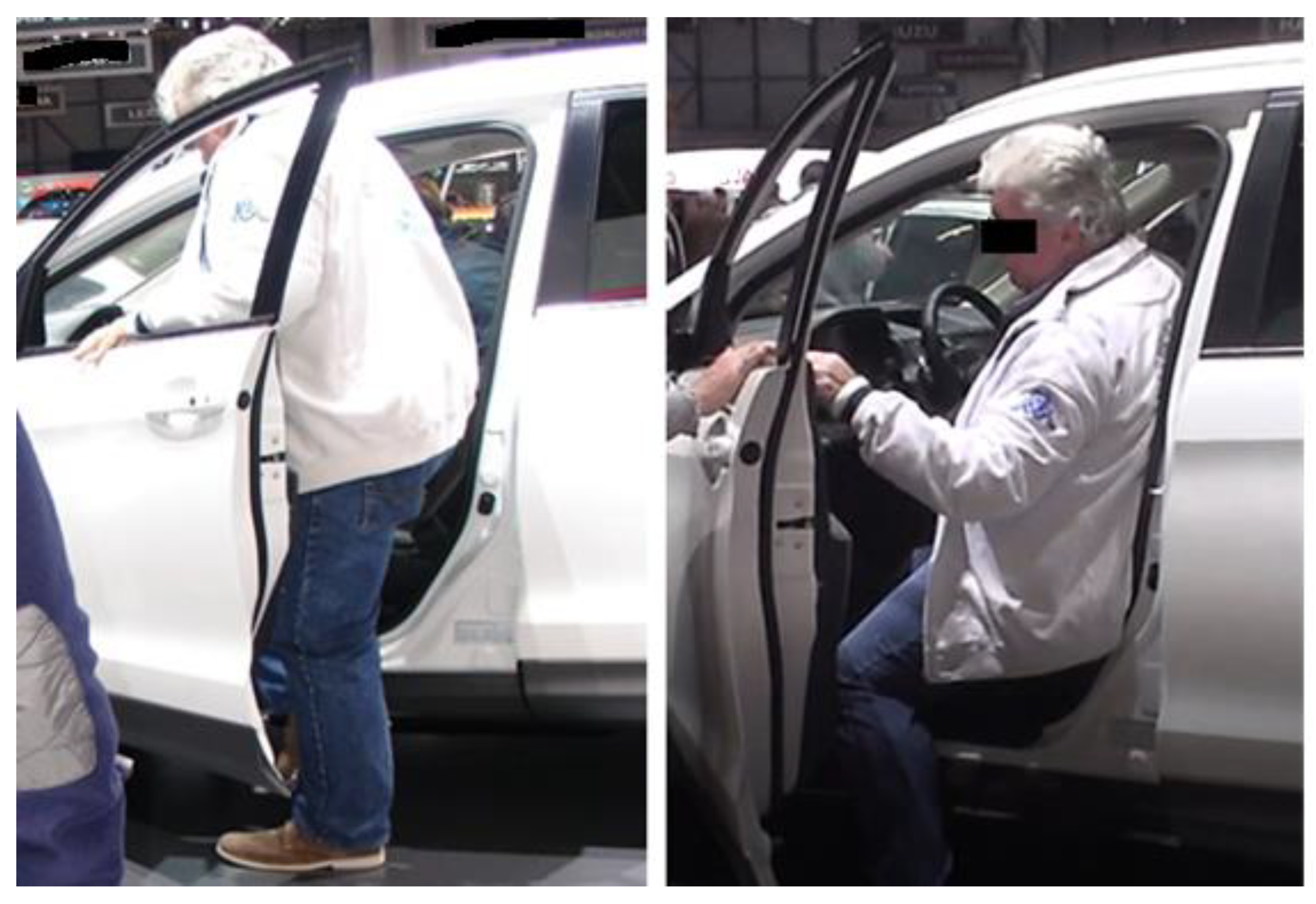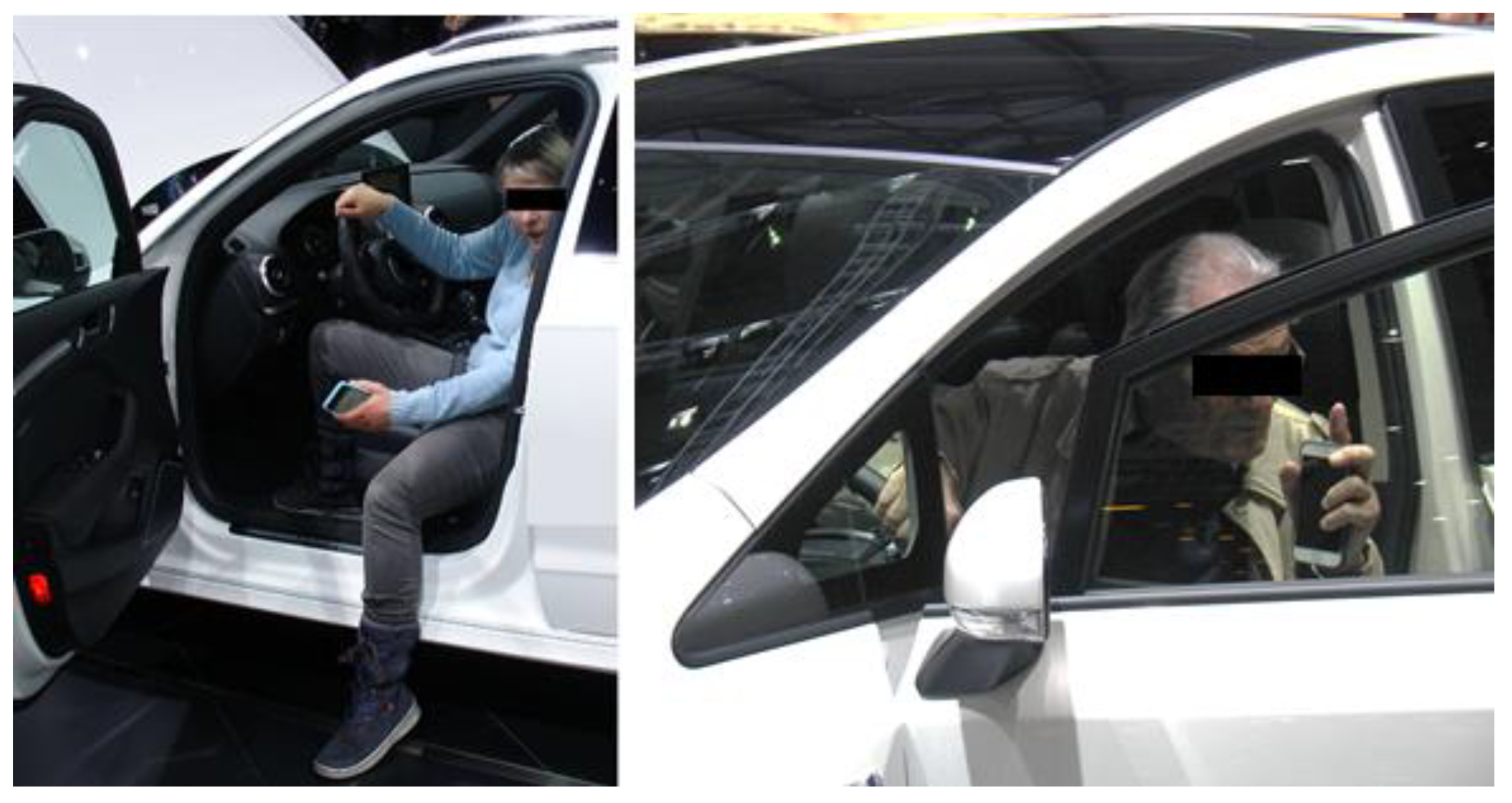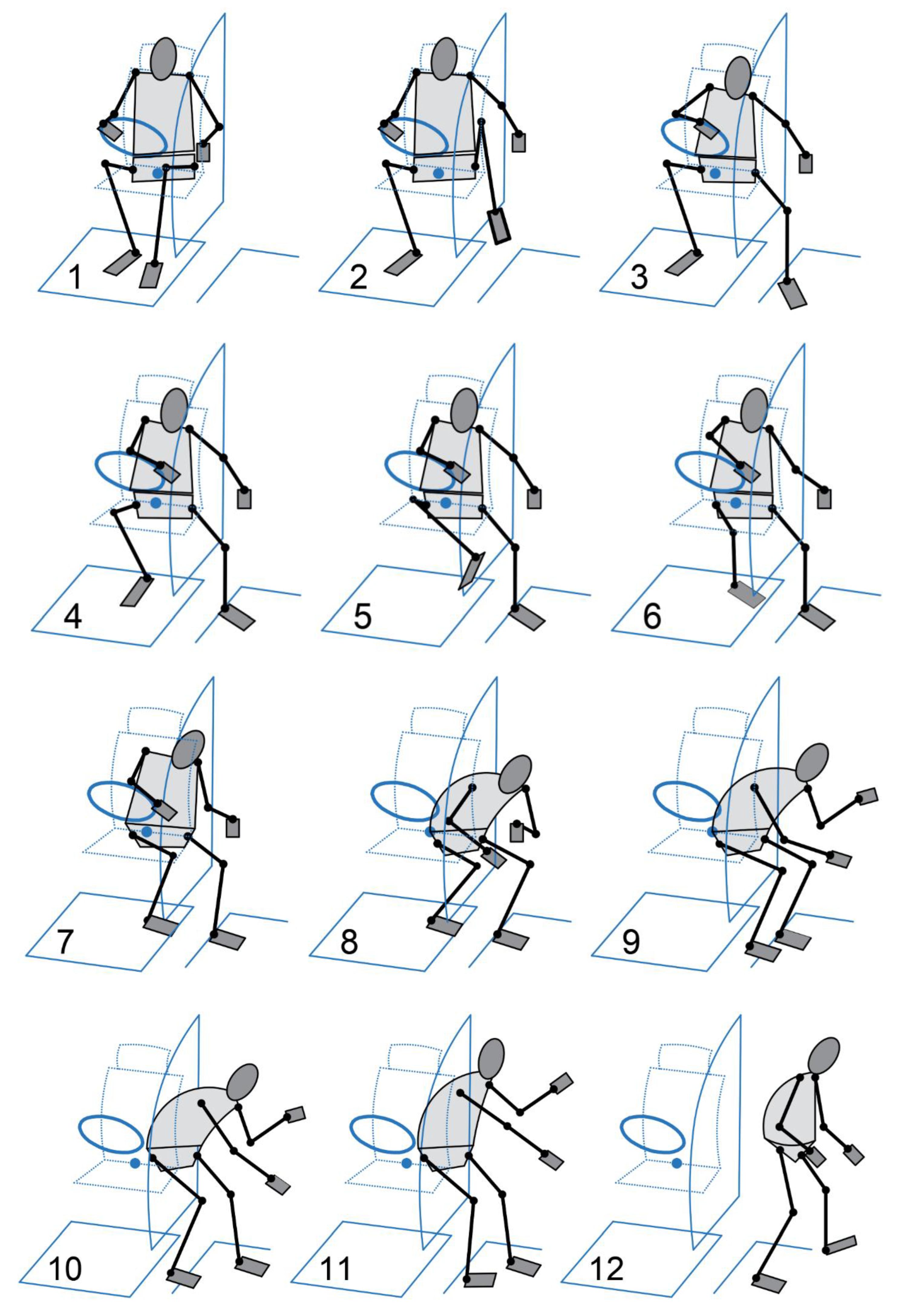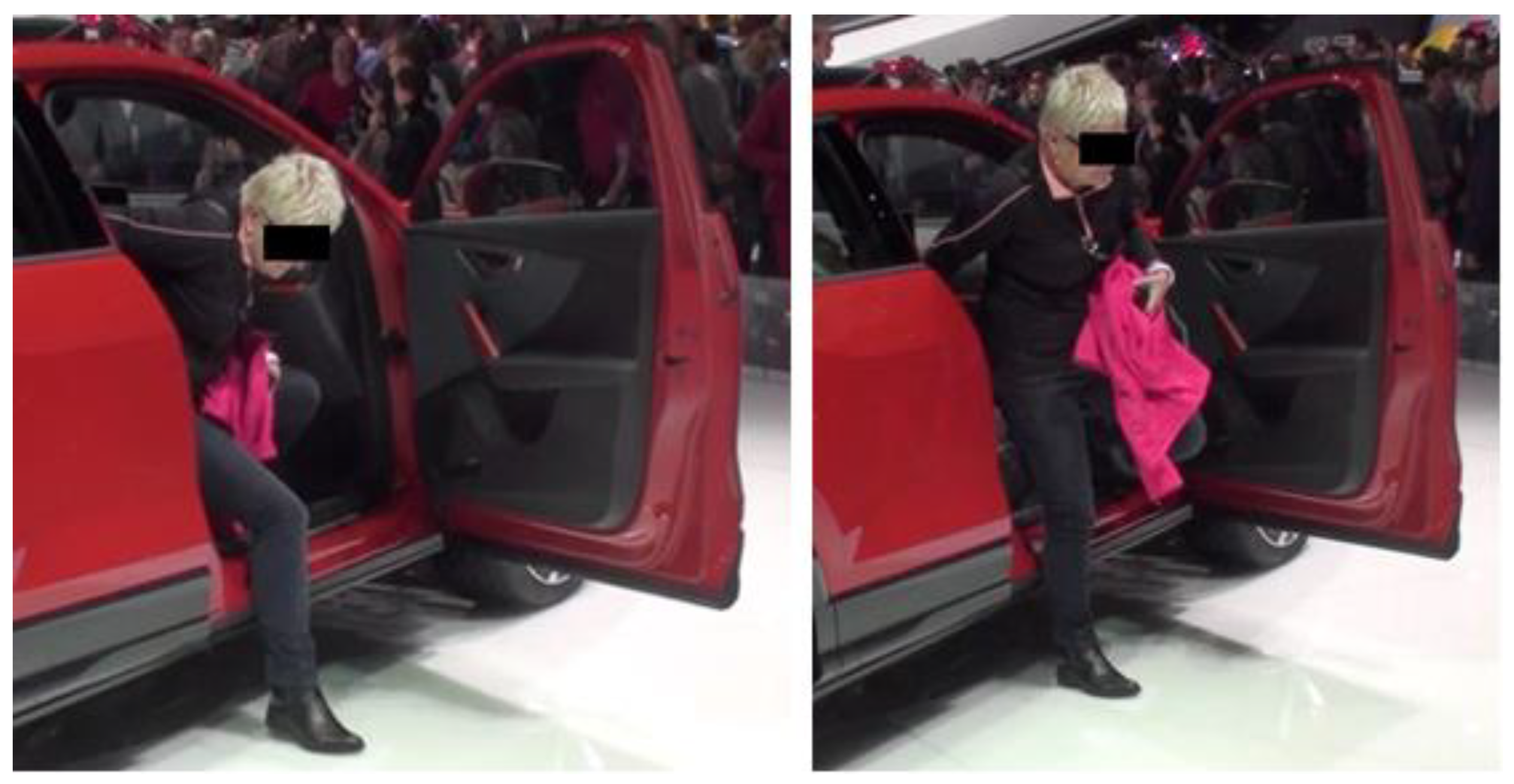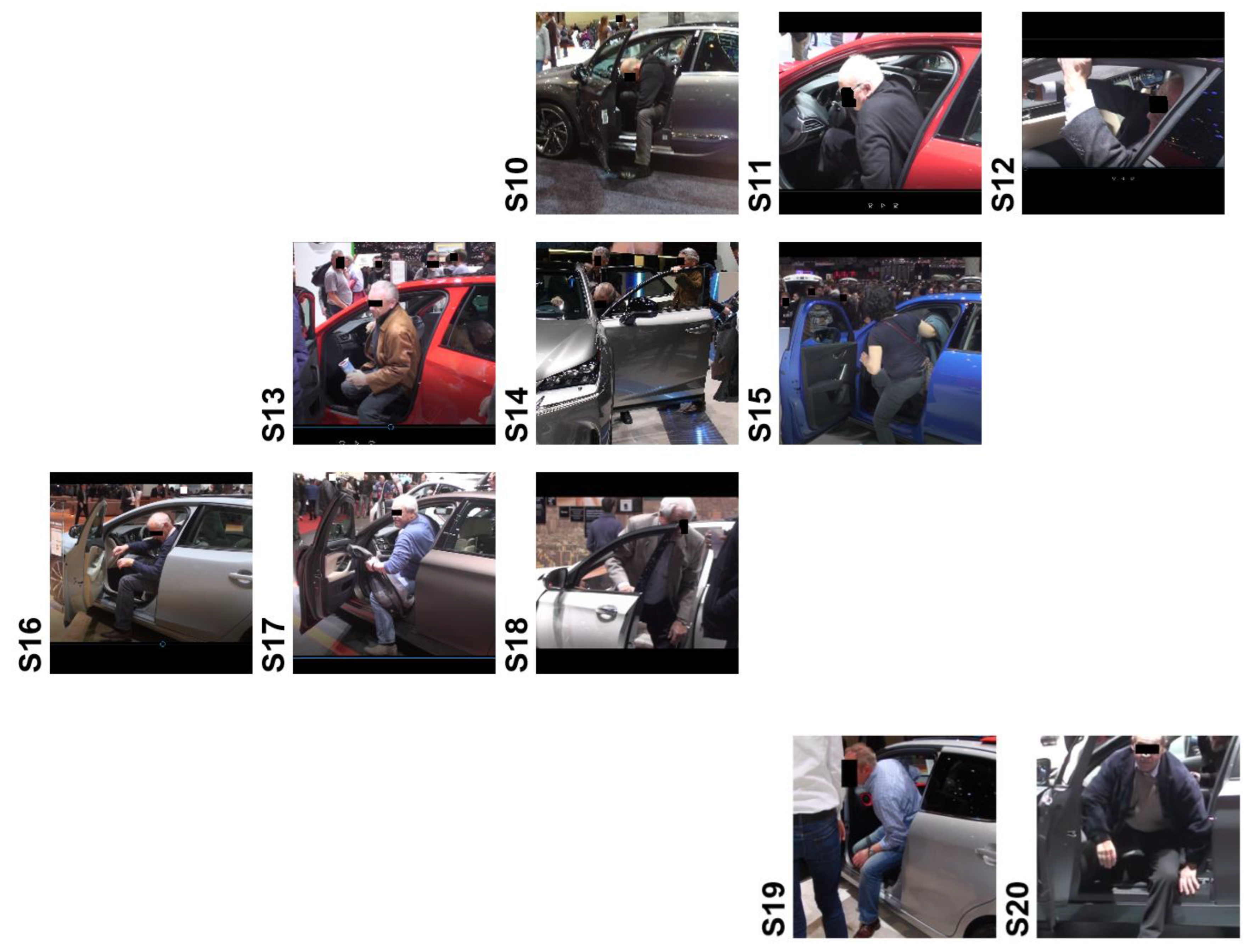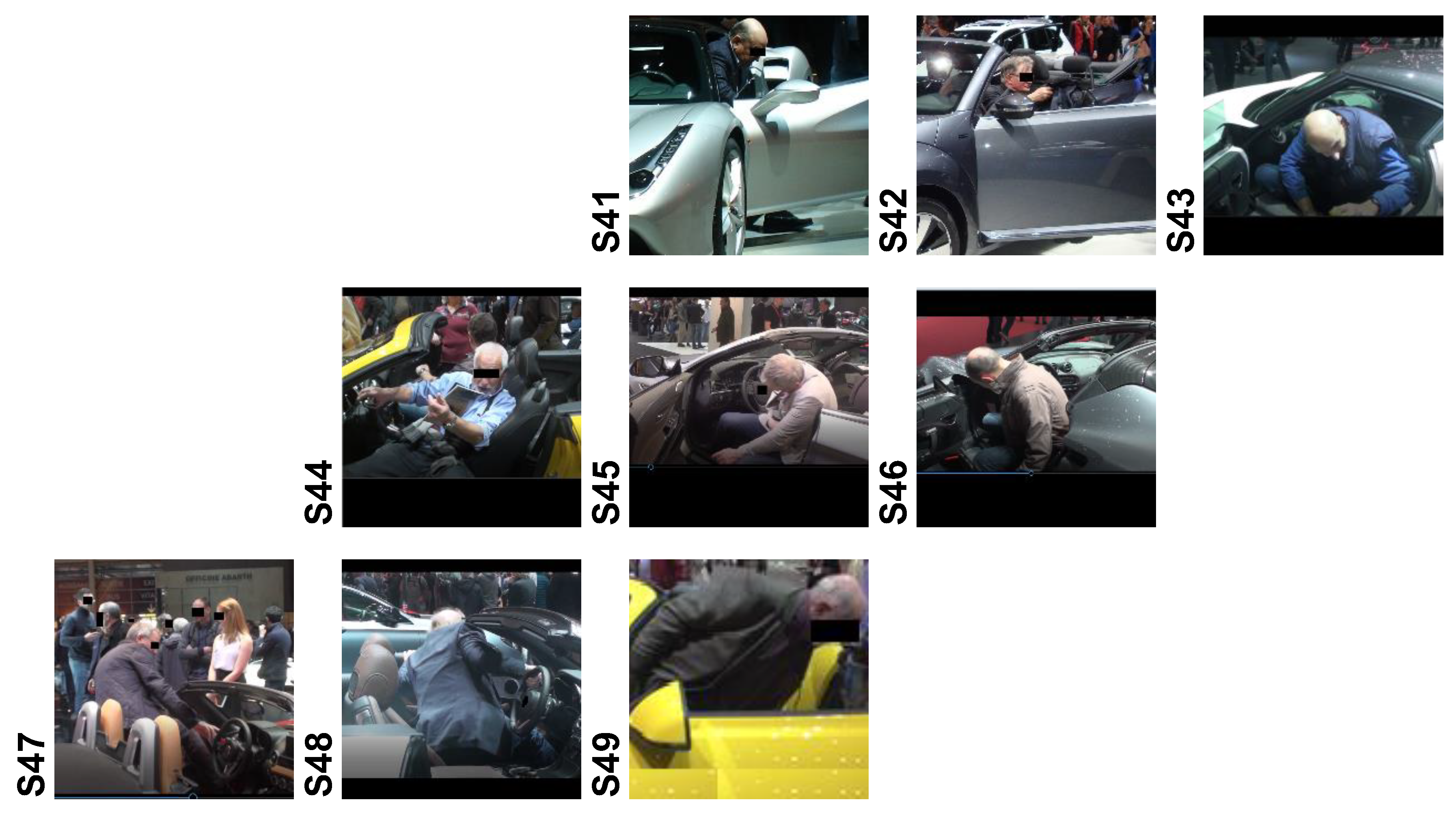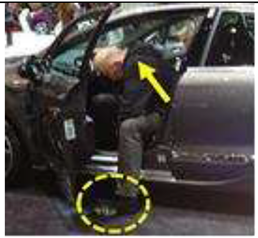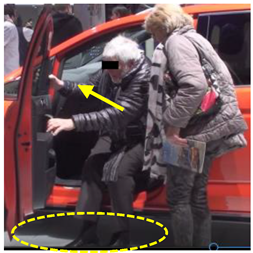1. Introduction
Many senior drivers begin to experience physical limitations long before they lose their driving skills. Decreased strength, balance, and flexibility, for example, lead to some subjects experiencing an increased challenge, such as getting in and out of vehicles [
1,
2]. As people age, there are obvious physical changes, namely at the psychomotor level and the biomechanical level of the musculoskeletal system, which are the origin of decreases in strength, motor coordination, balance, and precision of body movements [
3,
4,
5,
6].
The National Center for Injury Prevention and Control (part of the Centers for Disease Control and Prevention) in Atlanta estimates that, annually, in the United States of America (USA) alone, about 37,000 seniors suffer injuries when entering or leaving vehicles; 40% of these injuries are due to falls. People aged 65 and over are 10 times more likely to be hospitalized for injuries sustained while getting in and out of cars than younger people, and women are significantly more likely to be hospitalized. The probability of the injury occurring while exiting the vehicle is more than twice that of while entering [
7].
Considering that the senior population is increasing worldwide [
8] and that there is a high number of older drivers qualified to drive [
9], improving the experience of getting in and out of a car is a challenge for designers, planners, and engineers who are exploring solutions that improve automotive design, adjusting it to the limitations arising from the natural ageing process of users [
10,
11].
Entering and exiting a car are complex, multisensory experiences involving coordination, balance, and body movement. These somatic movements are usually performed without premeditation, and the body, through the psychosomatic experience, ends up adapting to the envelope and shape of the car [
12]. The somatic movements associated with the process of getting in and out of a car—bending, twisting, stretching, and tipping—create high biomechanical stresses [
13,
14]. Several aspects of psychomotor functioning decline with increasing age. Deficits in psychomotor functioning increase the difficulty in controlling movement when sitting down and standing up, as well as the difficulty in maintaining balance whenever the positioning of the trunk weight is varied. Some cognitive slowdowns, joint stiffness, and muscle weakness decrease reaction time and induce slower biomechanical movements [
15]. Leg stiffness originates from states of imbalance in terms of body positioning [
15].
Previous investigations [
16,
17] reveal that the experience of entering and leaving represents the initial interactions that the customer has with the vehicle and, therefore, constitutes a fundamental influence on the purchase decision. Car usability for the entry and exit process also requires particular attention, as the number of drivers who report discomfort in cars is still significant. Other authors [
8,
18] also add that minimizing the requirements and stress patterns arising from usability in the vehicle entry and exit process improves customer satisfaction.
In the past, car manufacturers conducted surveys to assess customer satisfaction regarding the entry and exit process of their car models. These questionnaires had the clear objective of assessing opinions about the ease of the entry/exit movements for their target audience, with a view to improving the development of future vehicles [
19,
20]. The answers obtained indicated a need to develop prototypes or physical models, on a real scale, with the purpose of testing the entry and exit movements required for the car. Using these evaluation methods (with questionnaire and prototype construction), the results suggested, for the most part, limitations correlated with the dimensions of the vehicles [
21]. However, the high costs associated with the construction of non-reusable prototypes, the high number of individuals needed to carry out the studies (for the sample to be representative), and the subsequent data analysis make this practice costly and not applicable right now [
22]. Currently, car manufacturers focus on delimiting any problems related to a car’s entry/exit process, even during the design phase [
23]. The evaluation of accessibility movements required to enter and exit a car is carried out, essentially, through simultaneous engineering, with evaluation methods that use numerical mannequins, which help to significantly reduce costs and production delays [
24]. Numerical dummies provide virtual models of the human user, capable of representing and even predicting their behaviour (user interaction with physical interfaces and the environment). The use of these models makes it possible to analyse and evaluate automotive ergonomics and, in this way, deduce the necessary requirements for the user [
25]. However, the movement strategies adopted in the simulator are restricted and do not allow to cover the universe of possible users [
26].
To better understand human behaviour, it is important to carry out detailed ergonomic analyses and/or anthropological studies and, only afterwards, simulate human movement. Research on the movement strategies adopted by users is an essential first step towards an accurate simulation [
23,
26]. The procedures used to determine movement strategies can be divided into two categories: (i) qualitative procedures based on observation and (ii) quantitative procedures based on automatic calculations [
19].
Constant technological improvements increase the potential of virtual reality techniques in computer simulation programs used by the automotive industry [
24,
27,
28]. Interactive simulated environments can be created using virtual reality techniques, which allows a quick assessment of the usability of the various project alternatives. This technology is particularly promising in anticipating and solving problems that are being considered in the design phase. The great difficulty is the correct integration of the virtual simulation in the design phase [
29]. Several researchers [
25,
27,
28,
30] suggest, as the most recommended methodology, the use of motion capture from optoelectronic systems with passive markers to measure the somatic movements of automobile accessibility. Although optoelectronic systems may have some instrumental and experimental errors, they are still among the most suitable systems for the study of complex motions.
The analysis of accessibility movements associated with a car also includes quantification and classification of the movements by strategies with the aim of refining the results of the analysis of the identified motor strategies to, thus, faithfully simulate the movement [
31]. Some studies of car accessibility have considered all entry and exit movements [
32,
33]. Others have their scope limited to either entry [
34,
35,
36] or exit [
28]. Some studies analyse movement strategies through the complete study of the human body, while others are focused on specific parts of the human body, namely, the head [
2,
21,
37] and the trunk [
37]. Other studies highlight the influence of some parts of the vehicle on car accessibility movements, such as the door sill [
38], seat height [
39], and roof height [
21,
38].
In this study area related to the somatic process of getting in and out of the car, investigations based on observational methodologies have proven very useful in increasing the understanding of human behaviour. However, the observation procedures do not provide accurate results, as they have a shortcoming in the lack of numerical reference marks essential to quantify and/or measure what is observed. Thus, research methods based on observation require great experience and knowledge to implement measures that effectively mitigate the observed results [
19,
31].
2. Materials and Methods
The research methodology is the visual method of qualitative analysis. The study uses local observation of seniors getting in and out of new car models. This observation is complemented by video and photographic recordings for further analysis and treatment of the collected data. The study is based on the premise that the subjects in the study did not know that they were being observed, which was a way of guaranteeing that the movements were processed in a natural and spontaneous way, with subsequent informed consent to participate in this study.
The location chosen for the investigation was the Geneva International Motor Show (GIMS) in Switzerland, an event that sets trends in the automotive sector and features numerous global car manufacturers exhibiting their vehicles, some of which will define the trends of future generations of vehicles. The study took place in pavilions 1, 2, 4, 5, and 6 over five consecutive days and lasted nine hours per day. The subjects studied were predominantly male (the major participants among the visiting public), with an estimated age of over 50 years. Records of couples (man and woman) trying to get in and out of vehicles with alternating positions were also obtained.
Despite the high number of records, only 49 subjects were included in the study because of the strict sample selection criteria and the informed consent requirement. Thus, for the study’s purposes, selection criteria were validated samples of subjects with variable anthropomorphology in three groups of vehicle typologies—each group containing three types of vehicles with variable dimensions and geometries, with steering wheel on the left —but homogeneous in characteristics. It should be noted that this study is not focused on vehicle brands but on vehicle typologies. So, vehicle manufacturers and brands will not be disclosed for ethical reasons and confidentiality. The adopted methodology can be described in five steps:
Step 1: Identification of the places with the greatest affluence and car experimentation by subjects of more advanced ages (sample of the relevant population to be studied).
Step 2: Observation of the strategies adopted in the somatic movement of entering the car, depending on the user’s physical capabilities (prevalence level of disabling conditions), passenger compartment area/space, and access position, as well as the shape and layout of the physical interfaces.
Step 3: Identification of the points of contact (physical interfaces with the driver) when entering the car and assessment of the effort or discomfort perceived by the user.
Step 4: Observation of the somatic movement strategies adopted when exiting the car, depending on the perceived user’s physical abilities, areas/spaces in the passenger compartment, and access positions, as well as the shape and layout of the physical interfaces of the car.
Step 5: Identification of points of contact, that is, the physical interfaces between the vehicle and the driver, when exiting the car and assessing the level of effort or discomfort perceived by the user.
That research presents some scope limitations. It is not extended to some car models classified as belonging to the classes considered “top of the range”, “very luxury”, and/or “super sports cars”, because they were contained in some of the pavilion’s sectors 1, 5, and 6 with restricted access to the general public.
The collection of visual records was not uniform over the five days of the experience during which the fieldwork took place since the influx of visitors to the exhibition hall occurred in different ways. Thus, in the last two days (weekend), we had difficulties collecting valid images as well as collecting participation informed consent due to the greater influx of visitors.
As pre-screening criteria of images (video) by filming technique, only records in which the entry/exit movements were fully observed in any type of vehicle, without external interference (or overlapping of images with other subjects not the object of study), were considered valid. This procedure reduced the valid sample to a group of 33 subjects. However, subsequent records analysis collected using the filming technique allowed us to extend to 49 the number of subjects in the sample. We included subjects whose video records were interfered with in the filming field by other visitors who did not impact on analysis and understanding of the somatic movement strategies to enter/exit vehicles. Therefore, all visual records that met the following characteristics were considered valid:
- (i)
Subjects captured by the filming technique, with complete records of entry and/or exit movement, in any type of motor vehicle class, admitting small interferences (overlaps of the object of study of less than one-third of the total of the collected image—such as hands, arms, feet, and legs of other subjects (if they did not compromise interpretation of somatic movement strategies).
- (ii)
Subjects entering and exiting the car through the front area, that is, the area accessible from the driver’s cabin.
The study is heterogeneous because it considers a universe of 49 subjects comprising 47 men and 2 women with different levels of physical development for their ages. It should be noted that women were more frequently observed trying out the front occupant seat instead of the driver seat. The few records that were made of senior women getting in and out of a driver’s seat at the exhibition contained interferences in the filming fields by other subjects (men).
The types of vehicles were divided into three groups (
Table 1): T1, T2, and T3 because the vehicles’ dimensions are relatively homogeneous within each respective group. The Typology 1 (T1) group includes vehicle types city, utility, and sedan. The Typology 2 (T2) group includes vehicle types van, minivan, and SUV/TT. The Typology 3 (T3) group includes vehicle types luxury, sports/coupé, and cabrio.
The subjects were labeled S1 to S49. The level of experimentation of the groups and types of vehicles was not homogeneous. In the Typology 1 (T1) group, 20 records were validated, of which 9 were observed in utility vehicles and 11 in sedans. In urban vehicles, no valid records were obtained, with a level of experimentation being mostly carried out by young adults.
Figure 1 identifies the 20 subjects (S1 to S20) studied in the T1 vehicle typology (which groups utility and sedan models). In the Typology 2 (T2) group, 20 valid records were obtained, of which 4 were obtained in minivans and 16 in SUVs/TTs. In van-type vehicles, valid registrations were not obtained.
Figure 2 identifies the 20 subjects (S21 to S40) studied in the T2 vehicle typology (which groups the minivan and SUV/TT models). Finally, in the Typology 3 (T3) group, 9 valid registrations were obtained, of which 2 were in sports/coupé vehicles and 7 were in cabrio vehicles. No registrations were obtained for vehicles of the luxury segment due to limited access to the respective exhibition/experimentation areas.
Figure 3 identifies the 9 subjects (S41 to S49) studied in the T3 vehicle typology (which groups the sports/coupé and the cabrio). Therefore, the visual studies carried out focus mainly on the analyses of the somatic movements of senior subjects in/out of SUV/TT vehicles (33%), followed by sedan (22%), utility (18%), and convertible vehicles (14%). The remaining vehicles have residual expressiveness (minivan, 8%; sports/coupé, 4%)—
Figure 4.
3. Results and Discussion
To understand the movement strategies used by the subjects in the study, we adopted a cartesian X, Y, Z reference regarding the parts of the vehicle that influence these strategies. This reference is common to other previous studies in this investigation area, and we chose it to maintain a common analysis methodology. The axis system reference represents, in a simplified way: the base of the car—plane X, Y; the thresholds of the door—plane X, Z—and at the top point of the plane of the door is the imaginary plane of the roof; the driver’s front seat; the central point represents the “H” point—the reference point of the driver’s centre of mass in the driving position; and the steering wheel (
Figure 5).
As a reference of the human model to reconstruct the movement of entering the vehicle, we used the three-dimensional humanoid model (
Figure 6, left) adopted by the automotive industry and by other authors of pioneering studies in this area of investigation [
40,
41] to standardize and compare visual analysis methods. The humanoid model has 20 degrees of freedom and is intended to represent, in a simplified way, the parts of the human body and their respective joints. The model is composed of three open kinematic chains representing the lower limbs, the trunk, and the head. It should be noted that the upper limbs are not the target of analysis, as the movement strategies of these parts vary significantly among subjects. Based on this humanoid model, a new simplified model was designed for the analysis and demonstration of research results.
The observations made regarding the movements of entering the car confirm the results of the precursor studies [
32,
40], which point out a series of movements required to enter a vehicle, categorized into three phases: door opening; adaptation of the entrance movement; and positioning on the seat. The last two phases vary depending on drivers, who may use either a “one-foot” or a “two-foot” entry strategy, as each type of strategy requires a unique set of moves. The door-opening phase is consistent for all entry strategies. During the movement adaptation phase, the driver uses a one-foot or two-foot placement strategy.
3.1. Entry (ingress) strategies
In the present study, it was found that when users got into cars, they used one-foot or two-foot strategies, which can be subdivided into specific strategies. Five distinct entry strategies were identified (
Table 2): three one-foot entry strategies— (1) lateral sliding, (2) backward movement, and (3) forward movement; and two two-foot entry strategies— (4) leaning forward and (5) leaning back.
This investigation made it possible to identify which movement strategies were most used by seniors when getting into the car. Thus, 11 subjects used strategy (1); 17 subjects used strategy (2); 10 subjects used strategy (3); five subjects used strategy (4), and six subjects used strategy (5).
Figure 7 illustrates the corresponding percentages of movement strategies for the sample universe.
Figure 8. illustrates the percentage of strategies adopted during the entry movement by vehicle type.
From the analysis of the graphs (
Figure 7 and
Figure 8), it is possible to conclude that the movement strategies during the entry process into different types of vehicles were nearly uniform. Thus, there was no evidence of any type of movement strategy characteristic for a certain type of vehicle. This indicates that the main influencing factor in vehicle entry movement strategies may be related to individuals’ physical capacity levels and previous somatic movement experiences and not dependent on the geometry of the vehicle typology experienced. It becomes evident that individuals with greater physical limitations, especially at the locomotor level, and also older individuals adopted entry movement strategies that involved the simultaneous use of two legs, diverging only in terms of trunk and upper limb movement (sometimes with the torso forward, sometimes with the stride reclined backward). A relevant aspect associated with entry processes in vehicles using both feet (simultaneously) is the fact that users use areas to support their hands, which may be a factor to consider in the design and development process of future automobiles, as well as to be considered in 3D simulation computational software for product validation adopted by the automotive industry. If, on the one hand, movement strategies are dependent on the level of physical capacity of users, then, on the other hand, somatic experience and synesthesia cannot be dissociated from strategies and respective motivations. Older drivers who use cars more have acquired, through somatic experience, something like a sensory autobiography in the practice of doing so, which they tend to replicate in new situations.
3.2. Exit (egress) strategies
In this investigation, exit movement strategies can be characterized as a process with three distinct phases (as previously observed by Chateauroux & Wang) [
28]. The first phase begins after the driver opens the vehicle door and then moves one or both feet from inside the cabin to outside the vehicle. During this phase, increased hip flexion is performed to allow the driver’s feet to pass through the threshold of the doorway (along the Z-axis). The driver’s torso and head also rotate outward in preparation for exiting the vehicle. The second phase begins with the driver flexing the neck and leaning the body out of the vehicle, passing through the edges of the door frame (along the Z-axis). Like Chateauroux and Wang [
28], we observed that drivers transferred their weight to their feet. That is, in a two-footed movement strategy, weight is distributed equally across both feet, whereas in a single-foot exit strategy, weight is transferred to the left leg. During a one-foot strategy, the driver’s right foot is placed on the outside of the vehicle while the driver maintains balance by transferring body weight to the left foot. During the third and final phase of the exit strategy, drivers transition to an upright position, culminating in the closing of the door, thus signaling their exit from the vehicle. During the process of getting out of the car, these three phases can be divided into four movement sub-strategies, which are identified below:
- (1)
Back extension sub-strategy. Individuals extend their backs to lean on the backrest. The pelvis rotates backward on the seat, and they do not turn relative to the seat to exit.
- (2)
Lateral flexion sub-strategy. Individuals lean to the right side. The centre of mass of the upper body is shifted over the right thigh. The pelvis is rounded, and the left hip is raised relative to the right side.
- (3)
Sub-strategy of hip rotation over the back-supported seat. This consists of rotating the trunk and upper limbs on the seat towards the door, with the rotation carried out around the left part of the back that rests on the backrest.
- (4)
Rotation sub-strategy without backrest support. The strategy is very similar to the previous one, but in this case, the individual turns in the seat at the same time as pulling on the steering wheel. The back is not supported by the backrest.
In addition to the previously mentioned sub-strategies, it was possible for us to verify the variants already mentioned in the study by Chateauroux and Wang [
28]—one of the most complete studies in terms of evaluating the sub-strategies of the exit movement.
Given the size of the sample in this study, the main strategies were identified and the sub-strategies were not analysed, not least because variations were identified in the movements at the level of the upper limbs and trunk—which require future developments—compared to the sub-strategies of movement pointed out by Chateauroux and Wang [
28]. Therefore, to evaluate the car exit processes, we decided to examine the sample of individuals under study according to the model proposed by Ait El Menceur et al. [
32]. In this simplified model, three exit strategies are identified, of which two strategies are one-foot (head forward or parallel to the vehicle) and one is two-foot.
Table 3 identifies the individuals and points out the respective movement strategies adopted during the exit of the cars.
The research made it possible to assess which movement strategies were most used by seniors when leaving the car. Thus, 24 subjects used the type (1) exit strategy; 18 subjects used the type (2) strategy; 7 subjects used the type (3) strategy.
Figure 9 presents the corresponding percentages of the exit movement strategies for the sample universe.
From the analysis of the graphs (
Figure 9 and
Figure 10), it is possible to conclude that the movement strategies during the exit process in different types of vehicles were practically uniform for the universe of the sample. However, the most prevalent strategy was the one that uses only one foot on the way out with the head leaning forward, which corroborates the results shown in other pioneering studies in this research area.
The movement adopted in the process of egress of the vehicle is more complex and difficult, in general, than that observed for entering, requiring greater flexibility, agility/dexterity, and physical strength of individuals. The main factor that influences movement strategies during exiting vehicles, as verified for the entry process, is essentially related to the levels of physical capacity of individuals. Therefore, it was concluded that there was no significant change in the strategy adopted by individuals based on the type of vehicle. However, it should be noted that in the case of sports vehicles/coupés and cabrios, there is a tendency to adopt exit strategies parallel to the vehicle. This behaviour may be associated with the greater reclining angle of the seat base, which induces greater effort to leverage the hip, as well as the smaller cockpit space for the driver, which substantially limits forward reclining strategies. Thus, functional design problems associated with the component geometry of parts of these types of vehicles are more evident during the output process.
Figure 10 illustrates the percentage of strategies adopted during the exit movement according to vehicle typology groups.
The research showed that subjects with greater physical limitations, especially at the locomotor level, and the oldest subjects adopted exit movement strategies that involved the simultaneous use of two legs, diverging only in terms of the movement of the trunk and superior limbs (sometimes with trunk forward, sometimes leaning backward, sometimes resting hands on steering wheel, seat backrest, door frame, and others). Therefore, a very relevant aspect associated with exit processes in vehicles using both feet (simultaneously) is the fact that users find areas to support their hands (Figure A6). The handgrip zones are factors to be considered in future research work, but also to be considered in the design and development process of a car. There is also the need to assess the possibility of users carrying objects in at least one of their hands so those behaviours can be analysed.
5. Conclusions
The automobile effectively exerts an “attraction” on subjects, in general, and on seniors, in particular. This became even more evident due to the high number of visitors, especially those over 50 years old, who attended the GIMS. This finding made it possible to carry out studies of behavioural observation of seniors with relative ease, despite the high number of interferences in the images that occurred during filming. Naturally, those who visit GIMS do so with the aim of observing new car models and, only afterwards, if possible, trying them out, so this finding is obvious. However, at the beginning of the study, we did not expect to find such a high influx of seniors in this place; the numbers are demonstrative of the high interest of seniors in cars. Despite the difficulties with collecting and recording images that validated this study, as well as gaining subsequent approval (informed consent) from the subjects, it was not difficult to observe the subjects’ behaviour.
We concluded that seniors are more likely to try taller vehicle typologies, such as SUVs—especially crossovers, minivans, sedan models (five-seater city cars, family-type), and mid-high range (which tend to have higher cabins), as well as small Jeeps, although to a lesser extent than the types of vehicles mentioned above.
After getting into the car, almost all users closed the door, presumably with the aim of evaluating aspects of the passenger compartment design, such as comfort, comparing them to the actual driving situation (that they would find in their own vehicles).
It is concluded that the degree of effort in opening the door (hand on the handle/handle itself), weight, opening angle, height, and width of the door are important. Larger doors, with a greater opening angle, allow for faster access to the steering wheel. However, if the doors are too heavy, they can be difficult or awkward to open, especially when the user must pull the door while carrying a coat or bag in one hand. Discomfort when opening doors was observed mostly in SUV and TT vehicle typologies, given the robustness of the structures, weight, and larger dimensions of the door panel, both in height and width.
Some subjects, as they age, are more likely to be overweight and, in many cases, also have greater volume in the abdomen region. In the subjects observed with these anthropometric characteristics, we highlight individuals S6, S17, S22, S23, S28, and S37, who have greater height and volumetry. Given the perceived size, these seniors opted, right from the start, to try vehicles with larger passenger compartments and greater door width and height (Figure A1). Therefore, taller subjects with a higher fat mass index present greater difficulties, as do their opposites, that is, shorter and thinner individuals.
Consider, by way of example, subject S28. In this case, the SUV had the particularity of having its front door window open. Thus, in the absence of glass, the senior used the door frame to support his left hand and forearm, both during the entry and exit movements (
Figure A3,
Figure A12 and
Figure A13). Subject S28 did not show discomfort during ingress into the SUV for several reasons: (i) support of the left hand on the door frame, which facilitates balance and entry into the vehicle; (ii) support of the right hand on the steering wheel—in a round geometric shape and with a significant diameter; (iii) the highest vehicle passenger compartment height; (iv) the large dimensions of the door width and height; (v) the height of the seat above ground level—the position at the centre of the individual’s thigh—which implies not having to bend down too much to enter; (vi) side cushions on the seat and on the backrest of the front seat that are not very pronounced; (vii) ample volume of the driver’s cabin.
Subject S28, during the egress, demonstrated some discomfort (Figure A14), perceived by the support of hands and position on the seat. This discomfort was due to several factors, namely: (i) the proximity of the front seat to the steering wheel (the seat should have been slightly moved back)—the driver’s obesity, especially in the abdomen region (Figure A15), made him lean his belly against the steering wheel during the exit movement and created some resistance on the exit; (ii) the fabric used to cover the front seat, which creates some friction and restricts movement; (iii) the high height of the doorway, which presented as “like a step on a ladder”.
Despite some perceived discomfort for S28 in leaving the SUV, this type of vehicle is the best option for seniors with greater physical stature, weight, and body volume. Accessibility in lower-to-the-ground vehicles, such as sports and utility models, provides greater discomfort for this type of user. Individual S17 (Figure A2), for example, a little shorter in stature, had difficulties like those of individual S28 when getting out of a sedan. This is because, proportionally, the smaller physical stature of S17 also corresponded to smaller dimensions in the sedan (such as door dimensions—height and width—and volume of the driver’s cabin compartment).
Despite the absence of studies on the behaviour of the upper limbs (for example, shoulder girdle, arm, forearm, and hand), we observed that they make a high contribution to body balance and minimize discomfort in car accessibility, especially in subjects with a greater fat mass index. For example, it is common for the left hand to rest on the inside handle of the door panel (Figure A1, left and right images) and the right hand to rest on the steering wheel (Figures A2, A3, and A4), especially during entry.
We can conclude that another aspect that exerts a strong influence on movement strategies when both entering and exiting the car, regardless of the physical stature of the individual and the type of vehicle, in terms of hands and postural balance, relates to whether the individual is carrying personal objects, such as a piece of clothing—usually a coat (Figures A2, A3, A7); a wallet; a bag or a backpack (Figure A1, left, and Figure A5); a mobile phone (Figure A8); or a book or magazine (Figure A9). These behaviours characterize situations that can occur naturally during the daily use of cars, which justifies further studies in this area, given that this constitutes a perceived gap in previous investigations.
A very relevant aspect associated with exit processes in vehicles using both feet (simultaneously) is the fact that users use areas of the car to support their hands (Figure A6). The handgrip zones are factors to be considered in future research work, but also to be considered in the design and development process of a car. There is also the need to assess the possibility of users carrying objects in at least one of their hands to assess their respective behaviours.
The existing literature on movement strategies for entering and exiting a car is silent when dealing with users’ interaction with the main parts of the vehicle and the influence of handholds. In this research, while exiting the car, subjects made rotational movements of the hips, trunk, and upper limbs on the seat, with support of the upper limbs on parts of the vehicle, such as the steering wheel and the door panel, which assumed special importance for physical balance and for the adoption of comfortable positions. To illustrate this behaviour, observed recurrently in the studied individuals (
Figure A11), the vehicle model with cartesian references and the humanoid model were used, as presented in
Figure 5 and
Figure 6.
If, on the one hand, the inclination of the seat influences a person’s ability to exit the car, on the other hand, a more appropriate choice of materials used in the construction of the front seats can help all movement strategies. Materials such as leather or synthetic leather make it easier to slide the body in or out of the seat than fabrics (textiles).
The steering wheel is an important support point in both entering and exiting the car. Many of the individuals in the study leaned on the steering wheel during the movement, which is why, in addition to being round, the wheel must have considerable thickness or diameter to improve hand support.
It is demonstrated that vehicle entry/exit movement strategies are strongly dependent on the physical capacity of the users and that older people have greater difficulties in accessing a car, with some types of vehicles being more favourable to minimizing this discomfort (e.g., SUVs).
The somatic experience and synesthesia cannot be dissociated from movement strategies and respective motivations, which were more prominent in the individuals under study when they exited the vehicles. When comparing entry and exit movement strategies, it appears that individuals who adopt two-foot entry processes tend to also use both feet to exit. The study also concluded that the type of vehicle does not, by itself, influence the movement strategies adopted by users, as shown by the results in Table A10. The human body, as it were, acquires a memory of the experience that it tends to replicate in new situations/experiences.
This research had the main advantage of allowing the evaluation of the entry and exit movements of new car models without any conditioning of the behaviour of the studied individuals since they initially did not know that they were being observed. Therefore, they were not predisposed to try to reproduce movements that they considered the “normal” pattern and/or to hide constraints motivated by physical limitations associated with age. Furthermore, experimenting with a “new” car highlighted the effect of the user’s somatic experience, as well as the true constraints and critical points of the main physical interfaces to be considered in the evaluation of car design.
Considering the size and sampling technique used, the conclusions and observed facts should not be taken as generalizable to the senior population. The sample is not representative of the pre-senior and senior population in general, namely in terms of human anthropometry; age group; health status; physical condition; the geometries and dimensions of the vehicles; and gender. More detailed future studies are recommended to measure the results of the investigation. However, being an exploratory study, it allows for corroborating limitations in senior individuals, previously identified in the literature, and identifying aspects of improvement at the ergonomic level and the design of the physical interfaces involved in accessibility to the interior of the car.6. Patents
This section is not mandatory but may be added if there are patents resulting from the work reported in this manuscript.



